I thought it would be cool to learn more about the traditions of my ancestors. Cool, right? Looks like my peeps let the kids run around at Easter Mass with willow branches (preferably pussy willow as palms are not readily available) and whip the evil out of eachother...maybe not such a bad idea - kinda like counseling your peers, right? I wonder if the adults can get in on the action - I know an adult or two that could use a good whippin'. I was relieved that they get good and liquored up after watching the kids exercise the demons...LOL Hopefully you will at least enjoy a vodka and think of me this Easter - Love you all!
Ukrainian Easter Customs and Traditions
Ancient Traditions
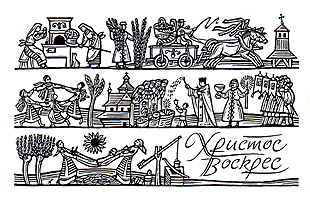
Jacques Hnizdovsky; Greeting Card from The Ukrainian Museum Gift Shop |
The traditions which originated in the ancient, pre-Christian times in Ukraine reflected the religious outlook, social structure and the way of life of the people.
The pre-Christian, pagan religion evolved into various cults which worshiped natural phenomena such as the sun, moon, stars, rain (water), fire and wind. There were also animal cults and cults of plants, such as special trees and magical herbs. These religious beliefs stemmed from the phenomenon of life and death and were also dictated by the repetitive cycle of Nature. The settled, agrarian mode of life of the ancient people of Ukraine also impacted on the formation of their religious beliefs.
Helpless in the face of Nature's power, the people felt that by means of rituals which consisted of dances, rhythmic gestures, incantations and special offerings, they could please and appease Nature.
Spring heralded the rebirth of Nature and the emergence of new Life after a long cold and inert winter. Spring was eagerly awaited, greeted and celebrated when it arrived. Various rituals were performed on its behalf, because this was the most important season of the year in an agrarian society. These rituals consisted of songs, group dances, the baking of special breads, burning of fires, coloring eggs, decorating pysanky and dousing with water.
With the introduction of Christianity to Ukraine in 988 A.D. the Church adopted many of these annual rituals into the Christian holidays. As a result the Ukrainian traditions are rich and deeply symbolic in their content.
Pre-Easter
With the coming of Christianity to Kyievan Rus' (see the
History of Ukraine Chronological Tables: 10th century), the Church merged the pagan Spring holiday with Easter - the Resurrection of Christ. Many of the ancient rituals became a part of the Easter cycle of celebrations.
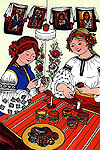
The first sign of the coming of Spring was the return of migrating bird flocks. To greet the birds, the harbingers of Spring, people baked dough birds. These were given to the children who frolicked in the fields by throwing the birds into the air while singing appropriate songs and offering prescribed sayings. The Church incorporated this tradition into the Feast of the Forty Martyrs which is celebrated on March 22nd.
On the Sunday before Easter, which is also called "Willow Sunday" branches of the willow tree (called loza) are blessed in the Church and given to the faithful. This particular ritual had a magical intent in pagan times. The willow tree had medicinal properties, was considered a holy tree, and was one of the first in the Spring to show signs of life. The people believed that by tapping each other with the freshly blooming willow tree branch, they could draw from it the same energy and strength which allowed it to come to life. The Christian Church on the other hand, marks this Sunday in accordance with the Gospel and the liturgical prescription celebrating the entry of Jesus into Jerusalem where he was greeted by throngs of people waving palm branches. To remember this event, the Church initiated a custom of distributing palm branches. The Ukrainian Church combined the ancient pagan ritual with the Christian one, with the difference that willow branches are given to the people instead of palm branches.
The week before Easter is called "white, clean, illuminating, grand, Passion Week or willow week." The days were busy with physical and spiritual cleansing and rebirth. Following supper on Passion Thursday and until Easter morning it was forbidden to eat meat or dairy foods. On Thursday evening the Twelve Gospels of Christ's Passion were read during a special service in Church. The attending faithful held large lit candles or three candles, called passion candles, tucked in a bed of aromatic herbs. In olden times these candles were made from bees wax by the master of each household. Following the service the faithful walked home with the lit candles. Through the year these candles were kept in a safe place until the following year's Passion Thursday. The people believed that the candles had magical powers which could protect the house from lightning, prevent hail from ruining the crops, and deter illness.
During the night before Easter or sometimes even on Thursday and Friday, men and boys lit bonfires near the woods, on hills, by the water, in cemeteries or near the church. According to belief, these fires were meant to cleanse the neighborhood of all evil illness and disaster. The flames also lit the way for the souls returning to their former families. A token household item was thrown into the bonfire as a sacrifice to the gods to insure prosperity during the year.

PASKA - Easter Ritual Bread
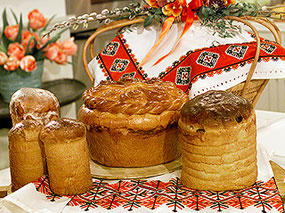 |
| Paska baked by Lubow Wolynetz (The Ukrainian Museum) as seen on Martha Stewart, April 2000. |
The most honored Easter bread was the paska and the preparation and baking of paska was considered one of the most important tasks of the year. People believed that the future could be predicted, depending on how this holiday bread turned out. Every homemaker wanted her paska to be the best and the biggest, therefore while baking it she performed various magical gestures and used incantations.
The dough for the paska was kneaded in a trough which rested on a pillow so that the bread would be light. During the preparation the homemaker had to maintain pure thoughts. While the paska was in the oven no one was allowed to sit or make a loud noise for fear it would collapse in the oven. In some regions of Ukraine the man of the house stood guard in his front door lest someone enter and cast an evil spell while the paska was baking.
A successfully baked paska brought great joy to the family. Wrapped in a rushnyk (ritual cloth), or placed in a basket, the paska was carried to church by the master of the house to be blessed in a ceremony following the Resurrection Mass on Easter morning. Other foods such as cheese, butter, salt, pork fat, horse radish, eggs, pysanky (Ukrainian Easter egg), ham, sausages, as well as various seeds were also brought to church for the blessing. Immediately after the ceremony the family would hurry home to share the blessed paska and thus begin Easter breakfast.
The antiquity of the paska as a ritual bread is evidenced not only by the rituals performed during the preparations and baking but also by the decorations which adorned this holiday bread. The top of the paska was covered with symbolic signs made of dough such as a cross, solar signs, rosettes, leaves, pine cones and sometimes even birds and bees. Most of these decorations were remnants of an ancient pagan religion tied to the cult of the sun and bread.
EASTER
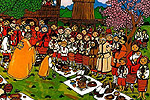
The Resurrection Mass was always eagerly awaited. In olden times a was held in the early morning before the rising of the sun. At that time in history all churches in Ukraine were built to face the East. When the Mass was ending and the priest first said "Chrystos Voskres" (Christ Has Risen), the doors of the church would be opened and the rays of the rising sun would envelop the faithful. Following the Mass the people greeted each other in the traditional way, by kissing each other three times. This is called "chrystosuvania"
The people would then stand outside the church with their baskets filled with the food which they had prepared for the blessing ceremony. A lit candle was always placed in the baskets which were decorated with aromatic herbs and periwinkle.
HAHILKY-VESNIANKY (HAYIVKY)
Ritual Spring Songs and Dances
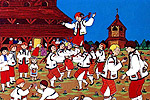
On Easter Sunday, young girls performed hahilky in front of the church or in the cemetery. In pagan times hahilky were performed in sacred groves by the water. These group dances, songs, games and dramatic scenes were believed to serve a magical function with the aim of enticing Spring and chasing Winter away. These songs and dances personified a funeral for frost and winter. They also imitated planting and growth of crops, and tried to ensure a bountiful harvest through the magic of music, words and body motion.
With these dances and songs the people attempted to entice and enchant all the good spirits of the reawakened Nature so that it would bring them good luck and wealth. Hahilky addressed various subjects. In some the dancers walked in a circle imitating the rotation of the sun in the sky, while in another the gestures showed the continuity of human life on earth. There was also a group of hahilky that spoke about the beauty and industriousness of young maidens, since Spring was also a time when love blossomed.
Lubow Wolynetz
Curator of Folk Art Collection
The Ukrainian Museum in New York City
Copyright by The Ukrainian Museum UM
Second Avenue New York, N.Y. 10003 (212) 228-0110
Text source:
The Ukrainian Museum
Greeting Cards:
Prints from original glasspaintings by Yaroslava Surmach Mills
See the BRAMA EASTER RESOURCE GUIDE for all cards and gift items.



EASTER BASKET
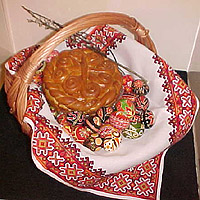
Easter Basket on display at The Ukrainian Museum |
The Easter basket is the pride and joy of the family. People judge the mistress of the house according to the way her Easter basket looks, what it contains, and how it is decorated.
The basket should be lined with a newly embroidered serviette or with a white napkin. An embroidered serviette should be used to cover the basket. Very ambitious housewives have two embroidered serviettes - one for lining the basket and one for covering it.
Remember, the basket should contain only a sampling of the foods you are going to eat at Eastertime not the entire contents of the refrigerator.
The Easter basket should contain:
| PASKA | Place a candle into the center of the paska and light it when the priest begins the blessing ceremony. |
| BABKA | |
| PYSANKY | Easter eggs, new ones every year |
| KRASHANKY | dyed eggs - variety of colors, but there must be a red one |
| EGGS | hard boiled and peeled |
| SALT | a small amount |
| BUTTER | should be nicely shaped and decorated with whole cloves and placed on a small dish or on top of the cheese |
| CHEESE | sweet cheese: mix farmer cheese with confectionery sugar, raisins, cinnamon, cloves and nutmeg. Place on a dish and on top you can place the butter. |
| HORSERADISH | a piece of the root or prepared horseradish with beets |
| KOVBASA | sausage - a small ring |
Tie a few willow branches to the handle of the basket with a red ribbon. Spring flowers and periwinkle can also be added. Do not use plastic flowers.
Text source:
The Ukrainian Museum
See the BRAMA EASTER RESOURCE GUIDE for all cards and gift items.



PYSANKY
(Ukrainian Easter eggs)
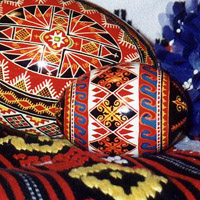
Easter egg, pysanka, decorating is one of the most interesting expressions of Ukrainian folk art. This tradition is very old and its beginnings reach back to antiquity, when in attempting to understand creation, ancient people developed myths in which the egg was perceived as the source of life, the sun and the universe. Although such similar myths are found in many cultures of the word, Ukrainians today are one of the few groups of people who still strongly adhere to many of the ancient traditions associated with the egg.
Text source:
The Ukrainian Museum
BRAMA Pysanka images
See the BRAMA EASTER RESOURCE GUIDE for all cards and gift items.
EASTER RECIPES
The Ukrainian Museum
About Pysanky
Pysanky Slide Show
Pysanky & Supplies Shop
Surma - The Ukrainian Shop
Pysanky images and tutorial
Pysanka supplies at Surma



PASKA
(Easter "babka")
Starter: 2 oz. yeast (2 packages of dry yeast)
1 tbsp. milk
1 tbsp. sugar
2-3 tbsp. water
Dissolve the yeast in the above mixture; wait until it bubbles and then add
4 cups sifted flour
2 cups warm milk
Mix all ingredients and wait until the dough rises.
To the mix add:
8 cups flour
3 whole eggs
8 egg yolks
1/4 lb. (or 8 tbsp.) sugar
1/4 tsp. salt
1 vanilla sugar
lemon rind of 1 lemon
juice of 1 orange
1 jigger of rum or other spirits (brandy)
1/4 lb. melted butter
Mix all the ingredients together. Add butter at the very end. Knead well for about 1/2 to 3/4 of an hour, until the dough is elastic. The dough will be very stiff. If it is too stiff, add 1/4 cup milk. Place the dough in a warm spot and let it rise until double in bulk.
When ready, fill greased and floured pans 1/2 or 1/3 full with dough. Make dough decorations for the tops of the pasky: solar motifs, square crosses, scrolls, braids, rosettes, birds, etc. Place the pans in a warm spot and let the dough rise until it reaches the top of each pan. Brush the tops of the dough with an egg wash. Bake in a preheated oven at 400 for 10 minutes, and then at 325 for additional 45 minutes. When done, take the pans out of oven and wait until the pasky cool in the pans. Then, carefully take them out of the pans and place gently on a cloth-covered pillow. Allow to cool completely.
DECORATIONS FOR THE TOP OF THE PASKA:

Illustrations are from the top looking down.
Set aside some dough to roll into smaller "tubes" with which to create these designs.
INCANTATIONS for a successful paska. Upon placing the paska into the oven say: "Holy paska, be as grand and beautiful as the sun, because we are baking you for the sun. Let all members of our family be healthy. Let our children grow up as quickly as you grow. "Come out as beautiful as you go in!"
DO'S and DONT'S:
- When preparing paska dough and during the kneading, think only good thoughts, shoo away all evil ones.
- Don't let any of your neighbors or worse – strangers - come into the house when you are preparing the paska. They might put an evil eye on your paska and it will not rise as it should. Don't make any sudden noises while the paska is rising or while it is in the oven baking. Also, don't sit down while the paska is in the oven or it will become flat.
- If you carefully follow all of the above instructions, the paska will be light, airy and tasty.
- If not - the paska will come out hard and dense. Then the people will say: "Even thunder and lightning will not break this paska".

The first sign of the coming of Spring was the return of migrating bird flocks. To greet the birds, the harbingers of Spring, people baked dough birds. These were given to the children who frolicked in the fields by throwing the birds into the air while singing appropriate songs and offering prescribed sayings. The Church incorporated this tradition into the Feast of the Forty Martyrs which is celebrated on March 22nd.
On the Sunday before Easter, which is also called "Willow Sunday" branches of the willow tree (called loza) are blessed in the Church and given to the faithful. This particular ritual had a magical intent in pagan times. The willow tree had medicinal properties, was considered a holy tree, and was one of the first in the Spring to show signs of life. The people believed that by tapping each other with the freshly blooming willow tree branch, they could draw from it the same energy and strength which allowed it to come to life. The Christian Church on the other hand, marks this Sunday in accordance with the Gospel and the liturgical prescription celebrating the entry of Jesus into Jerusalem where he was greeted by throngs of people waving palm branches. To remember this event, the Church initiated a custom of distributing palm branches. The Ukrainian Church combined the ancient pagan ritual with the Christian one, with the difference that willow branches are given to the people instead of palm branches.The week before Easter is called "white, clean, illuminating, grand, Passion Week or willow week." The days were busy with physical and spiritual cleansing and rebirth. Following supper on Passion Thursday and until Easter morning it was forbidden to eat meat or dairy foods. On Thursday evening the Twelve Gospels of Christ's Passion were read during a special service in Church. The attending faithful held large lit candles or three candles, called passion candles, tucked in a bed of aromatic herbs. In olden times these candles were made from bees wax by the master of each household. Following the service the faithful walked home with the lit candles. Through the year these candles were kept in a safe place until the following year's Passion Thursday. The people believed that the candles had magical powers which could protect the house from lightning, prevent hail from ruining the crops, and deter illness.During the night before Easter or sometimes even on Thursday and Friday, men and boys lit bonfires near the woods, on hills, by the water, in cemeteries or near the church. According to belief, these fires were meant to cleanse the neighborhood of all evil illness and disaster. The flames also lit the way for the souls returning to their former families. A token household item was thrown into the bonfire as a sacrifice to the gods to insure prosperity during the year.

The Resurrection Mass was always eagerly awaited. In olden times a was held in the early morning before the rising of the sun. At that time in history all churches in Ukraine were built to face the East. When the Mass was ending and the priest first said "Chrystos Voskres" (Christ Has Risen), the doors of the church would be opened and the rays of the rising sun would envelop the faithful. Following the Mass the people greeted each other in the traditional way, by kissing each other three times. This is called "chrystosuvania"
The people would then stand outside the church with their baskets filled with the food which they had prepared for the blessing ceremony. A lit candle was always placed in the baskets which were decorated with aromatic herbs and periwinkle.HAHILKY-VESNIANKY (HAYIVKY)On Easter Sunday, young girls performed hahilky in front of the church or in the cemetery. In pagan times hahilky were performed in sacred groves by the water. These group dances, songs, games and dramatic scenes were believed to serve a magical function with the aim of enticing Spring and chasing Winter away. These songs and dances personified a funeral for frost and winter. They also imitated planting and growth of crops, and tried to ensure a bountiful harvest through the magic of music, words and body motion.
With these dances and songs the people attempted to entice and enchant all the good spirits of the reawakened Nature so that it would bring them good luck and wealth. Hahilky addressed various subjects. In some the dancers walked in a circle imitating the rotation of the sun in the sky, while in another the gestures showed the continuity of human life on earth. There was also a group of hahilky that spoke about the beauty and industriousness of young maidens, since Spring was also a time when love blossomed.Lubow Wolynetz
Easter egg, pysanka, decorating is one of the most interesting expressions of Ukrainian folk art. This tradition is very old and its beginnings reach back to antiquity, when in attempting to understand creation, ancient people developed myths in which the egg was perceived as the source of life, the sun and the universe. Although such similar myths are found in many cultures of the word, Ukrainians today are one of the few groups of people who still strongly adhere to many of the ancient traditions associated with the egg.
